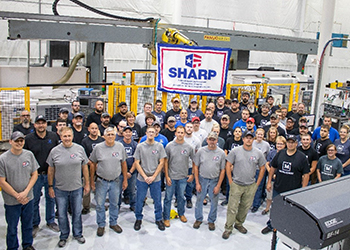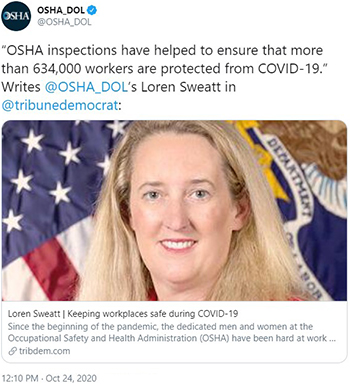QuickTakes Newsletter
November 2, 2020 • Volume 19, Issue 19 • A twice-monthly newsletter with information about workplace safety and health.

COVID-19 Guidance
New respiratory protection guidance was issued for long-term care facilities during the coronavirus pandemic.


Coronavirus Citations Issued
Read about more OSHA enforcement cases.
Protecting Workers from COVID-19 Hazards
OSHA has removed 643,291 workers from COVID-19 hazards during the coronavirus pandemic.
Pandemic Response
- A recent blog post from Loren Sweatt provides tips to keep workers safe from the flu and prevent it from spreading.
- The Electrical Transmission and Distribution Partnership and OSHA developed a wellness bulletin on protecting workers from seasonal flu and COVID-19.
Small Business Recognized for Safety
A machine shop was accepted into OSHA’s Safety and Health Achievement Recognition Program after working with the On-Site Consultation Program to eliminate workplace injuries.
Partnership to Protect Workers
Choate Construction and the Associated General Contractors of Georgia partnered with OSHA to protect workers during a nursing home construction project.
Alliance Promotes Workplace Safety
The Montana Renewable Energy Association is partnering with OSHA to serve as an ambassador for workplace safety.
Safety Settlement
Target Corp. signed a settlement agreement to correct exit and storage hazards, and enhance safety at 200 stores.
Whistleblower Protection
A rail-based freight transportation company was ordered to reinstate an employee who reported a hazard and injury.
COVID-19 Q&A
Will an N95 respirator protect the wearer from the virus that causes COVID-19?
Yes. “N95” refers to a class of respirator filter that removes at least 95% of very small (0.3 micron) particles from the air. Some people have mistakenly claimed that since the virus that causes COVID-19 is approximately 0.1 microns in size, wearing an N95 respirator will not protect against such a small virus.
When an infected person expels the virus into the air by activities like talking, coughing, or sneezing, the airborne particles are composed of more than just the virus. The virus is part of larger particles that are made up of water and other materials such as mucus. These larger particles are easily trapped and filtered out by N95 respirators because they are too big to pass through the filter.












